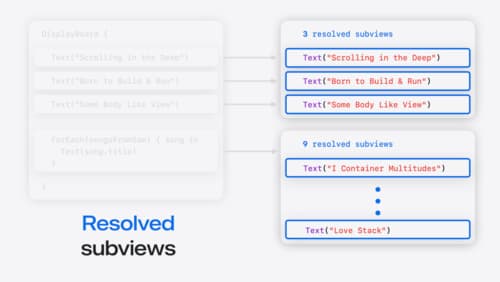How to write better SwiftUI Views
Asked on 2024-08-02
1 search
To write better SwiftUI views, you can follow several key principles and techniques highlighted in the WWDC sessions:
-
Declarative Syntax: SwiftUI views are declarative, meaning you describe what you want the UI to look like, and SwiftUI handles the rendering. This makes your code more readable and easier to maintain. For example, you can create a horizontal stack with a label, spacer, and text using a few lines of code (SwiftUI essentials).
-
Composition: Break down your UI into smaller, reusable components. SwiftUI's composition model allows you to build complex interfaces by combining simple views. This approach not only improves code organization but also enhances performance (SwiftUI essentials).
-
State-Driven Views: SwiftUI views are state-driven, meaning they automatically update when the underlying state changes. This eliminates the need for manual UI updates and reduces the potential for bugs (SwiftUI essentials).
-
Adaptivity: SwiftUI views are adaptive, meaning they can adjust to different environments and contexts, such as dark mode, accessibility settings, and localization. Use Xcode previews to quickly see how your views look in different scenarios (SwiftUI essentials).
-
Custom Views and Modifiers: Create custom views and use view modifiers to encapsulate and reuse functionality. For example, you can add a
searchablemodifier to a list to enable search functionality with minimal code (SwiftUI essentials). -
Low-Level Control: For unique custom experiences, SwiftUI provides low-level APIs that allow you to build custom control styles, use canvas for high-performance drawing, and even apply custom Metal shaders directly to SwiftUI views (SwiftUI essentials).
-
Use of Containers: Understand and utilize SwiftUI containers like
List,ForEach, and custom containers to manage and display collections of data effectively. This helps in creating flexible and dynamic UIs (Demystify SwiftUI containers).
By following these principles and leveraging the powerful features of SwiftUI, you can create efficient, maintainable, and visually appealing user interfaces. For a deeper dive, you can explore the sessions mentioned:

Get started with HealthKit in visionOS
Discover how to use HealthKit to create experiences that take full advantage of the spatial canvas. Learn the capabilities of HealthKit on the platform, find out how to bring an existing iPadOS app to visionOS, and explore the special considerations governing HealthKit during a Guest User session. You’ll also learn ways to use SwiftUI, Swift Charts, and Swift concurrency to craft innovative experiences with HealthKit.

Migrate your TVML app to SwiftUI
SwiftUI helps you build great apps on all Apple platforms and is the preferred toolkit for bringing your content into the living room with tvOS 18. Learn how to use SwiftUI to create familiar layouts and controls from TVMLKit, and get tips and best practices.

Demystify SwiftUI containers
Learn about the capabilities of SwiftUI container views and build a mental model for how subviews are managed by their containers. Leverage new APIs to build your own custom containers, create modifiers to customize container content, and give your containers that extra polish that helps your apps stand out.
